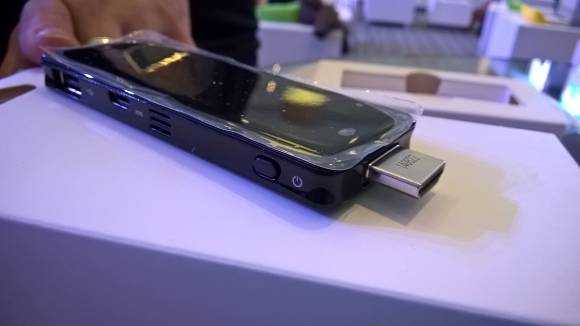ConsoleOS is a tailored build of Android (AOS) for X86 PCs. It’s optimized with features for keyboard and mouse, an anti-virus package and then it’s tailored for use with an expanding list of devices. The company that makes it is about to market ConsoleOS on a tiny X86 HDMI stick called iConsole Micro and it’s one of most interesting ultra mobile PCs I’ve checked out for a long time.
Give me Android on my TV and a dual-boot capability with KODI or Openelec and I can put 2 systems into one HDMI port on my TV. It might even replace my Fire TV Stick and Chromecast. With the power of the Intel Compute Stick (that iConsole Micro is based on) I should also be able to get some fun Android gaming out of it. I’ve had hands-on, and an ‘unboxing.’ Here’s what I have so far.
Inside iConsole TV (and all products based on the Intel Compute Stick) is an Atom Z3735F quad-core 1.33-1.8 Ghz Baytrail-T platform the same as you find in a lot of cheap Windows 8.1 tablets. There’s 32GB of storage inside the iConsole Micro and you get a full-size USB 2.0 port, a micro USB port (for power) and there’s WiFi and Bluetooth inside which will allow you to connect to a WiFi hotspot and pair a keyboard and mouse without using the USB port. A Micro SD card slot allows you to expand the internal storage up to 128 GB. The bootloader unlocked but it’s a 32-bit version which isn’t supported well on current 64-bit operating systems. There are ways to get it working though and I hope to see Openelec running on it ASAP! There’s no word on the RAM yet. 1 or 2GB is possible.
The announced price is $129 and availability is planned for summer. I’ve requested an update on that and I’ll update this post when I get the information.
iCOnsole usage ideas
- iConsole Micro will ship with Android 5.0 which means it’s fully encrypted by default (not the Micro SD) which opens up some interesting data transport options.
- The processing power should be enough for all Android games.
- iConsole Micro is an interesting option for a HTPC. The platform can handle 50+ Mbps of H.264 with hardware decoding according to my tests on Windows. hopefully that hardware is supported in Android.
- With a USB-Gigabit Ethernet port is can be a router or hotspot.
- Tails or other security-focused Linux builds should work well on this if the 32-bit bootloader is supported.
- Bluetooth controllers should work with Android.
- The Amazon store will be included meaning you have access to official apps. Sideloading of apps will be possible. There’s no Google Play system.
- With no screen this should be easy to power using a power bank or solar panel for headless operations.
One thing to note is that there are Windows tablets available using the same platform, offering the same specifications for the same money and including the screen and a battery. Not all of them have an HDMI output and none of them have a full size USB port meaning that charge+data is a little difficult but that might not be an issue for some people. What’s interesting with iConsole Micro is that you’re getting a fully working Android 5 build on X86 and judging by some of the interest there should be a good community around it.
Update: Liliputing have just published a review of the Intel Compute Stick which will give you some idea of the performance available when using Windows and the problems of loading other operating systems through the 32-bit bootloader.
I interviewed Chris Price at MWC in Feb where we go the first look at iConsole Micro.











